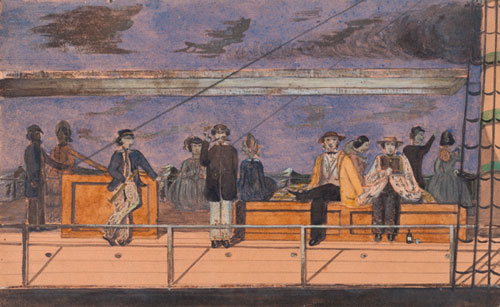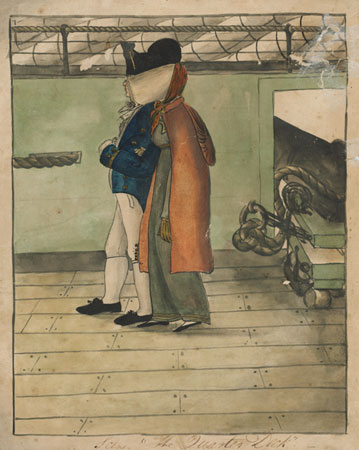Life on board
Most passengers experienced cramped conditions when travelling on 19th century emigrant ships. All were required to provide suffient clothing, utensils, and bedding for the long sea voyage and even cabin class passengers were required to outfit their own berths for the voyage.
Clothing and supplies needed during the voyage were stored in a canvas bag, while the remainder was packed into trunks and stowed in the ship's hold. Depending on the ship, and the weather, passengers may have had access to their trunks only once or twice during a voyage. In bad conditions, many emigrants were stuck in damp, dirty clothes and bedding for weeks at a time.
 Detail, 'A fine day in the Atlantic', from Our Voyage to Australia:
Detail, 'A fine day in the Atlantic', from Our Voyage to Australia: brief sketch, diary, 6 October-23 December 1853,
by W. S. M. Watercolour sketch. DLMS 168
Handbooks were available to help emigrants prepare for the voyage with advice about what to expect on board. Publications like P. B. Chadfield’s Out at sea; or the emigrant afloat (1863) provided information about the choice of ship, the best time to sail, the fitting up of a berth, outfit and extra provisions, rations and how to cook them, messes and dinners, what to take and how to take it, and social life on board ship.
Emmigrant guides suggested that a man should pack six shirts, three Guernsey or flannel shirts, six pairs of stockings, one pair of good stout shoes, one pair of good stout boots, one suit of warm outer clothing, one suit of light clothing and an extra pair of trousers, one light cap, and one warm cap, or southwester. An adult woman needed six chemises, six pairs of stockings, two flannel petticoats, two lighter petticoats, two pairs of good boots or shoes, one good warm cloak with hood, one hat or light bonnet for warm weather.
Passengers were divided into messes of between six to ten adults before boarding. Each mess would cook, eat and draw their rations together. Those in steerage, second and third class cabins were required to cook their own food. Meals could include rice pudding, sea pie, pea soup, and oatmeal porridge. Different classes of ticket dictated passengers’ rations. Those who could afford to would often bring extra jam, sugar, biscuits, eggs, cheese and ham.
William Tinsley describes a ‘fine dinner’, in his journal kept while on board the Cardigan Castle, of potatoes, pickles, preserved onions, potted meat, and pudding. Passengers often experienced difficulties cooking and eating during storms at sea, when a strong roll or high swell could throw everything off the table. William and Laurence Kennaway’s journal was so focused on food that it was published as 'Biscuit and Butter: a colonist’s shipboard fare'. It recorded not only the food eaten during the voyage but also passengers’ changing attitude to food the longer they were at sea: ‘pork and other greasey sorts of food that used to be rejected as a matter of course are now finished up and the dishes leave the table empty ….’
Emigrants had to be out of bed by 7am, with all the children washed and dressed before breakfast at 8 am and then sent off to school. At 9 am the decks were cleaned and groups assigned to clean areas of the ship that didn’t belong to a particular mess. Dinner was at 1 pm, tea at 6 pm and lights out at 8 pm. Government regulations determined the daily routine on board British emigrant ships as well as many private ships leaving English ports. Steerage passengers were required to clean their own berths (as were some second and third class passengers) and this was how most emigrants started their day. Regulations also dictated the timing of religious services and weekly musters for inspections by the Surgeon Superintendent, wash days and daily cleaning of the ‘coppers’.
Afternoons were usually free for emigrants to do as they liked. Depending on the weather, leisure time was spent sewing, reading or writing letters and diaries. In his 'Diary from London to Sydney 1882-1883', John Maffey recorded that (when not occupied by his medical duties) he was kept busy writing and editing the shipboard newspaper.
Emigrants were often restricted in their movement on board. Single men were usually berthed in the bow, married couples in the middle, and single women in the stern. First class passengers had exclusive use of the poop deck and entertained in their cabins or the saloon. Passengers with lower classes of ticket could enter this area by invitation only. Single women were closely supervised by the matron, who was responsible for their physical and moral wellbeing, and were kept physically separated (usually fenced off) from the rest of the passengers and sometimes locked down at night.
> Read about the different class distinctions on emigrant ships
> Discover what the voyage was like for female emigrants
> View sketches capturing their daily life and activities


